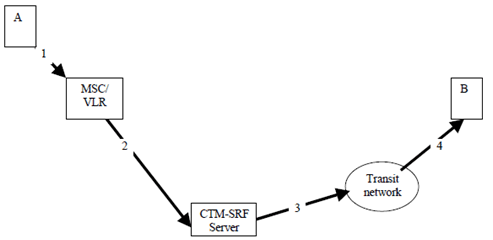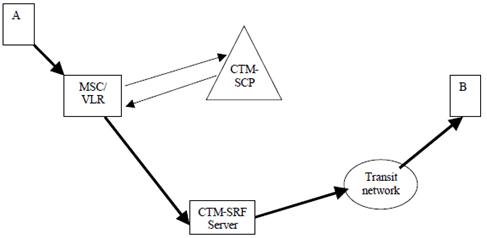Content for TS 23.226 Word version: 18.0.0
C GTT-Voice specific information for the CTM-SRF core network node solution
C.1 Emergency calls
C.2 Routing of regular user calls
C.3 Routing actions of the CTM-SCP
C.4 Routing actions of the CTM-SRF
C.5 Service interactions
$ Change history
C GTT-Voice specific information for the CTM-SRF core network node solution p. 20
This clause describes a method how to route possible text calls via a core network node called the CTM-SRF. It should be taken as an informative example. It is based on CAMEL Phase 1 and call signalling with ISUP. Other call control environments and other IN service platforms can accomplish the same result.
This clause shows how emergency calls, terminating calls and originating calls can be routed through the CTM-SRF node without any modification to existing core network nodes. This covers also mobile-to-mobile calls.
For cases where emergency call support for text calls is wanted, all emergency calls are routed to the CTM-SRF server. The CTM-SRF server routes the call to the emergency centre. This can be done, as the CTM/textphone conversion channel itself is transparent to speech.
Originating and terminating calls, from and to possible text telephone users, are handled as CAMEL calls. A CAMEL service assures that the calls are routed through the CTM-SRF node by actions of a CAMEL application.
C.1 Emergency calls p. 20
The network has no means to distinguish text emergency calls from voice emergency calls in areas where the same number is used for both types. It may also be desired that even a phone borrowed for the purpose of making a text emergency call shall get the text service without any specific text subscription. Therefore, in order to meet these requirements, it shall be possible to configure the network to route all emergency calls through CTM-SRF server nodes.

If the emergency service use the same number for emergency text calls as for emergency voice calls, routing of all calls, regardless of text or speech, to a CTM-SRF server can be accomplished by configuration in the MSC/VLRs. The MSC/VLR can be configured in a way that, depending on the Emergency Centre addresses, emergency calls are always routed via a CTM-SRF server.
The CTM-SRF links in the CTM/textphone conversion function and routes the call further according to the received IAM.
The CTM-SRF node could recognise emergency calls by knowing all numbers of the emergency centres in question.
For US E-911-calls an additional method is given by looking at the CPC field. A special value is given.
- CPC "H'E0" represents "emergency service call".
C.2 Routing of regular user calls p. 21
Regular user calls that may contain text are routed to the CTM-SRF by a CAMEL service.
Text users are identified by a Text Telephony CAMEL Service Key (SK) and other CAMEL information stored in the HLR. The CTM part of this service modifies the Called Party Address (see following clauses). The call is routed through the CTM-SRF server and is then routed to the original destination.
C.2.1 Mobile Terminating calls p. 21

Figure C.2: Paths for routing of mobile terminating text calls with call path shown in thick arrows
(⇒ copy of original 3GPP image)
(⇒ copy of original 3GPP image)
The GMSC discovers that the user is a subscriber of the text telephony service, by the Camel Subscription Information information received from the HLR. The text Service Key is present and the Detection Point = Terminating_Attempt_Authorized.
The SCP with the text telephony service application is connected and the routing of the call through the CTM-SRF node is performed.
To control the activation of CAMEL service invocations an indication is sent from the CAMEL service via the CTM-SRF server back to the CAMEL service. This information is used by the CAMEL CTM-SCP service (2nd invocation) to do nothing but just to continue the call.
The indication is carried in the Calling Party Category parameter of ISUP.
This ISUP parameter is supported in CAP V1. InitalDP, and Connect. The CTM-SRF node and the CAMEL CTM-SCP service form an integrated application, and this ISUP parameter handling is regarded internal application signalling.
(no figure)
For the support of text users, the CAMEL CTM-SCP service will return the textphone-number with a CTM-SRF server prefix in CAP_CONNECT. The GMSC creates a new O-BCSM for this CAMEL based forwarding leg. It uses the Destination Routing Address in CAP_CONNECT to do the routing and to send the ISUP_IAM. The routing is based on the CTM-SRF server prefix part.
The CTM-SRF server links in the CTM/textphone conversion function and extracts Text subscriber address, Nature of Address, and the Numbering Plan Indicator from the Destination Routing Address parameter. It stores the original CPC value in Additional Calling Party Number parameter. If Called Party's Category is not received, then this information as such is encoded. It writes this information to the appropriate IAM parameters and routes the call to a GMSC. It could be the same GMSC as before or a different one.
The GMSC regards this incoming IAM as a new terminating call to a text subscriber. A second time a dialogue for the "same text call" to a CAMEL service is invoked. The service realises this fact and does nothing but connecting the call to the Text subscriber (Called Party Number, respectively Destination Routing Address has not been changed by the CTM-SRF server).
C.2.2 Mobile originating calls p. 22

The following sequence chart shows the mobile originating traffic case.

For normal originating calls the MSC finds the CAMEL text telephony Service Key in the VLR, together with information on the Detection Point = Collection of dialled digits. All non-emergency calls for the user will cause a connection to the text telephone service application in the CTM-SCP. The A-category value from the subscriber data in the VLR is used as CPC value.
The CAMEL service knows that it is an originating call. In this case it just forwards the Calling Party's Category parameter untouched.
The CTM-SRF removes its own address digits from the Called Party Address. The CTM/Text telephone conversion function is inserted before the call is routed towards the B-subscriber.
C.2.3 Mobile to Mobile Calls p. 23
Two CTM-SRF servers are linked in, one on the originating leg and one on the terminating leg. The originating ISUP_IAM sent from the CTM-SRF server on the outgoing side is received by the GMSC as normal ISUP_IAM.
C.3 Routing actions of the CTM-SCP p. 23
From the clauses above, it can be derived that the following actions are performed in the CAMEL server CTM-SCP acting on the CAP Interface.

Figure C.7: CTM-SCP Logic for Mobile Terminated case. Detection point =Terminating Attempt Authorized
(⇒ copy of original 3GPP image)
(⇒ copy of original 3GPP image)

Figure C.8: CTM_SCP logic for Mobile Originated case at detection point=Collection of dialled digits
(⇒ copy of original 3GPP image)
(⇒ copy of original 3GPP image)
C.4 Routing actions of the CTM-SRF p. 25


C.5 Service interactions p. 26
C.5.1 Interaction with other CAMEL services p. 26
The text users can use other CAMEL services. However, with other CAMEL services using the same Detection Point as the Text Telephone service, the other CAMEL services are impacted when using CAMEL Phase 1 as presented in this document.
As for the impact on existing CAMEL services, some of the services may be impacted anyway to support text users, for example Prepaid for playing announcement in text telephone signals.
Every CAMEL service, which is expected to be used by both voice and text users, and use the same CAMEL detection point as the GTT service, is assigned two SKs, one for non-text users and another for text users. For text users the other service logic has to integrate CTM-SCP routing logic.
C.5.2 Interactions with Supplementary Services p. 26
In general, no other interactions are expected than described in the CAMEL standard.
Call Forwarding in GMSC is invoked after terminating CAMEL service invocation. This means the CTM-SRF service node is already linked in the call path. A further invocation of a mobile originated CAMEL based service will cause an additional routing to a CTM-SRF service node. This is needed to convert the text back to text telephone coding, e.g. Baudot, which is required for the following routing towards the forwarded-to-party (C-party).
C.5.3 Emergency Call interaction p. 26
New emergency call categories introduced in 3GPP Release 4 (introduced as emergency-call enhancement) have no impact on routing of emergency calls via CTM-SRF server.
New categories may be specified in order to detect text emergency calls.
C.5.4 Usage of Destination Routing Address p. 26
The Destination Routing Address CAMEL parameter is used by the service logic for two purposes.
- It contains the CTM-SRF server address to let the MSC to route the call to the CTM-SRF server.
- It contains the original B-subscriber address, to let the CTM-SRF server to use it as Called Party Number on the outgoing side.
C.5.5 Inserting CTM/Text telephone conversion function p. 26
The CTM/Text telephone conversion function is direction oriented. A CTM modem should be connected towards the radio side and a modem for ITU-T Recommendation V.18 [4] or any of its text telephone submodes towards the other direction. Therefore the CTM-SRF server has to distinguish between mobile terminating and mobile originating calls.
This can be achieved by either allocating different channels for the directions or make decision based on the Called number to the CTM-SRF.
C.5.6 Lawful interception p. 27
Depending on where on the route the intercept is made, and also depending on the support for CTM in the terminal, the coding in the intercept point will be transmitted in CTM modulation and coding, or native PSTN text telephone coding and modulation. Both are possible to decode, and a combined decoder can be designed.